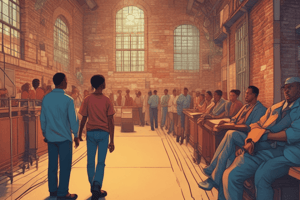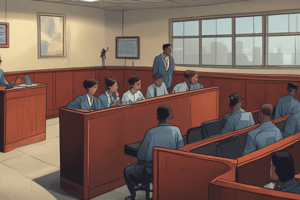Podcast
Questions and Answers
What is one example of market failure that might lead to a need for welfare?
What is one example of market failure that might lead to a need for welfare?
- Insufficient jobs available (correct)
- Excessive job opportunities
- Efficient economic exchange
- High rates of employment
Welfare is solely provided by government organizations.
Welfare is solely provided by government organizations.
False (B)
Name one type of organization that can provide welfare support apart from the government.
Name one type of organization that can provide welfare support apart from the government.
charities
After World War II, many countries set up __________ welfare systems between 1945 and 1975.
After World War II, many countries set up __________ welfare systems between 1945 and 1975.
Match the following welfare concepts with their descriptions:
Match the following welfare concepts with their descriptions:
Which type of risks relates to the unequal distribution of risks across different occupational groups?
Which type of risks relates to the unequal distribution of risks across different occupational groups?
Life-course risks include trajectories related to education, employment, and retirement.
Life-course risks include trajectories related to education, employment, and retirement.
Which region is considered the most equal in terms of income distribution?
Which region is considered the most equal in terms of income distribution?
What term describes the transmission of social risks from one generation to another?
What term describes the transmission of social risks from one generation to another?
The United States has one of the highest levels of economic development but is highly unequal.
The United States has one of the highest levels of economic development but is highly unequal.
In the post-industrial economy, non-standard employment includes part-time, __________, and temporary work.
In the post-industrial economy, non-standard employment includes part-time, __________, and temporary work.
What three phases characterize global inequality over time according to the content?
What three phases characterize global inequality over time according to the content?
Match the following concepts with their definitions:
Match the following concepts with their definitions:
Which of the following best describes old social risks?
Which of the following best describes old social risks?
Branko Milanovic grew up under _____ in Yugoslavia.
Branko Milanovic grew up under _____ in Yugoslavia.
What happens to global inequality measurements when recalculated by population size?
What happens to global inequality measurements when recalculated by population size?
The Pygmalion effect suggests that students from high socio-economic backgrounds receive less encouragement from teachers.
The Pygmalion effect suggests that students from high socio-economic backgrounds receive less encouragement from teachers.
Name one example of class risks related to job insecurity.
Name one example of class risks related to job insecurity.
Match the phases of global inequality to their characteristics:
Match the phases of global inequality to their characteristics:
Colonialism has been linked to rising inequality in the West.
Colonialism has been linked to rising inequality in the West.
What has been identified as a reason for the high levels of inequality in Brazil?
What has been identified as a reason for the high levels of inequality in Brazil?
What does convergence theory suggest about the economic development of countries?
What does convergence theory suggest about the economic development of countries?
The Four Traps Theory identifies three main factors that can hinder a country's economic growth.
The Four Traps Theory identifies three main factors that can hinder a country's economic growth.
Name one trap identified in the Four Traps Theory that affects countries struggling with poverty.
Name one trap identified in the Four Traps Theory that affects countries struggling with poverty.
Natural resource wealth can lead to the ______ trap if a country relies on it too heavily.
Natural resource wealth can lead to the ______ trap if a country relies on it too heavily.
Match the traps from the Four Traps Theory to their descriptions:
Match the traps from the Four Traps Theory to their descriptions:
Which theory explains the inequality among countries according to historical factors?
Which theory explains the inequality among countries according to historical factors?
A landlocked country has easier access to global trade compared to coastal countries.
A landlocked country has easier access to global trade compared to coastal countries.
What is one outcome of the bad governance trap as described in the Four Traps Theory?
What is one outcome of the bad governance trap as described in the Four Traps Theory?
Which of the following best describes life-course risks?
Which of the following best describes life-course risks?
Class risks are independent of socioeconomic status.
Class risks are independent of socioeconomic status.
What are intergenerational risks?
What are intergenerational risks?
Welfare is about meeting basic needs such as food, _____, and other essentials.
Welfare is about meeting basic needs such as food, _____, and other essentials.
Which type of welfare system is characterized by unequal coverage of risks?
Which type of welfare system is characterized by unequal coverage of risks?
Social indicators measure economic performance of a country.
Social indicators measure economic performance of a country.
What is one key aspect of welfare according to the content?
What is one key aspect of welfare according to the content?
What was a consequence of the Chinese cars entering the European market?
What was a consequence of the Chinese cars entering the European market?
Match the following welfare definitions with their descriptions:
Match the following welfare definitions with their descriptions:
The socio-economic left-right cleavage refers to deep divisions based solely on geographical location.
The socio-economic left-right cleavage refers to deep divisions based solely on geographical location.
Name one of the four cleavages distinguished in the content.
Name one of the four cleavages distinguished in the content.
According to Lipset and Rokkan, a cleavage can be defined as a deep and lasting division between groups based on some kind of ______.
According to Lipset and Rokkan, a cleavage can be defined as a deep and lasting division between groups based on some kind of ______.
Match the following types of cleavages with their definitions:
Match the following types of cleavages with their definitions:
What is one major structural element of a cleavage?
What is one major structural element of a cleavage?
The organizational element of a cleavage involves individual representations rather than collective action.
The organizational element of a cleavage involves individual representations rather than collective action.
What kind of cleavage is generated by large-scale historical processes like industrialization?
What kind of cleavage is generated by large-scale historical processes like industrialization?
Flashcards
Life-course risks
Life-course risks
The unequal distribution of risks across different stages of life, such as youth, mid-life, and old age.
Intergenerational risks
Intergenerational risks
Social risks that are inherited from one generation to the next, leading to cycles of poverty and inequality.
Class risks
Class risks
The unequal distribution of risks across different social classes, tied to socioeconomic status and occupational groups.
Old Risks
Old Risks
Signup and view all the flashcards
New risks
New risks
Signup and view all the flashcards
Standard Employment Relationship
Standard Employment Relationship
Signup and view all the flashcards
Non-Standard Employment
Non-Standard Employment
Signup and view all the flashcards
Social mobility
Social mobility
Signup and view all the flashcards
Gini Coefficient
Gini Coefficient
Signup and view all the flashcards
Gross Domestic Product (GDP)
Gross Domestic Product (GDP)
Signup and view all the flashcards
Global Inequality
Global Inequality
Signup and view all the flashcards
The Great Divergence
The Great Divergence
Signup and view all the flashcards
Phase I of Global Inequality (Pre-1950)
Phase I of Global Inequality (Pre-1950)
Signup and view all the flashcards
Phase II of Global Inequality (1950-2000)
Phase II of Global Inequality (1950-2000)
Signup and view all the flashcards
Phase III of Global Inequality (2000-Present)
Phase III of Global Inequality (2000-Present)
Signup and view all the flashcards
Convergence Theory
Convergence Theory
Signup and view all the flashcards
Four Traps Theory
Four Traps Theory
Signup and view all the flashcards
Conflict Trap (Four Traps Theory)
Conflict Trap (Four Traps Theory)
Signup and view all the flashcards
Natural Resource Trap (Four Traps Theory)
Natural Resource Trap (Four Traps Theory)
Signup and view all the flashcards
Landlocked Trap (Four Traps Theory)
Landlocked Trap (Four Traps Theory)
Signup and view all the flashcards
Bad Governance Trap (Four Traps Theory)
Bad Governance Trap (Four Traps Theory)
Signup and view all the flashcards
World Systems Theory
World Systems Theory
Signup and view all the flashcards
Historical Origins of Inequality
Historical Origins of Inequality
Signup and view all the flashcards
Labor Markets
Labor Markets
Signup and view all the flashcards
Market Failure
Market Failure
Signup and view all the flashcards
Civil Society
Civil Society
Signup and view all the flashcards
Welfare States
Welfare States
Signup and view all the flashcards
Moral and Political Questions
Moral and Political Questions
Signup and view all the flashcards
Cleavage (Lipset & Rokkan)
Cleavage (Lipset & Rokkan)
Signup and view all the flashcards
Structural Element of Cleavage
Structural Element of Cleavage
Signup and view all the flashcards
Cultural Element of Cleavage
Cultural Element of Cleavage
Signup and view all the flashcards
Organizational Element of Cleavage
Organizational Element of Cleavage
Signup and view all the flashcards
Critical Juncture
Critical Juncture
Signup and view all the flashcards
Urban-Rural Cleavage
Urban-Rural Cleavage
Signup and view all the flashcards
Labour-Capital Cleavage
Labour-Capital Cleavage
Signup and view all the flashcards
Center-Periphery Cleavage
Center-Periphery Cleavage
Signup and view all the flashcards
Social Indicators
Social Indicators
Signup and view all the flashcards
Realizing potential
Realizing potential
Signup and view all the flashcards
Market indicators
Market indicators
Signup and view all the flashcards
Meeting basic needs
Meeting basic needs
Signup and view all the flashcards
Study Notes
Introduction
- This document does not provide a singular topic or subject matter
- It is a collection of pages from a book and or lecture notes on globalization, the welfare state, and social risks, covering topics such as definitions, historical context, measurements, and consequences for different nations.
Lecture 1: Social Risks
- Risk: The probability of a dangerous event, multiplied by the expected damage.
- Social risks: Risks produced by systems, not individual failures, requiring collective responses.
- Examples: Unemployment, sickness, disability, and old age.
- Socioeconomic factors: Key aspects of social risk; influenced by circumstance.
- High risk, low vulnerability (e.g., Elon Musk)
- Low risk, high vulnerability (e.g., Single mothers)
Lecture 2: Globalization: Defining and Measuring
- Globalization: A process involving increasing cross-border flows of goods, services, money, people, information, and culture, leading to greater interdependence among global units.
- De facto globalization: Measures actual flows and activities (e.g., trade, migration).
- De jure globalization: Represents institutions, policies, and arrangements that enable or restrict flows (e.g., trade tariffs)
Lecture 3: Global Poverty and Inequality
- The Washington Consensus: Belief in unimpeded free markets driving economic growth.
- Neoliberalism: Encourages privatization & free trade while opposing state intervention.
- Globalization and the distribution of wealth: Globalization has reduced extreme poverty globally but has also led to greater disparities in national wealth and income distribution within countries.
- Trickle-down theory: Aims to boost the economy by reducing taxes on the wealthy.
Lecture 4: Globalization and the Welfare State
- Welfare state: A system of social risk management (through insurance & assistance programs) designed to protect citizens from risks of poverty, illness, unemployment, sickness etc. (e.g., universal healthcare, pensions).
- Globalization and Labor Market Flexibility: Globalization impacts labor markets through changes in flexibility (hiring/firing). This leads to concerns about job security, earnings, and welfare benefits.
- Impact on the welfare state: Globalization is impacting the welfare state, which may lead to more flexible systems but also to concerns of welfare systems (e.g., financialization of the global economy, leading to financial crisis; or increase in unemployment, and other social risks).
Lecture 5: The Politicization of Globalization
- Politicization of globalization: Globalization is a contested and politicized process.
- Welfare chauvinism: The idea that welfare benefits should be restricted to citizens of the same nationality.
- Globalization and migration: The increasing movement of people across borders has increased socio-political tensions related to competition for jobs, services and welfare benefits.
Additional Topics and Concepts
- Gini coefficient: A measure of income inequality.
- Kuznets Curve: A theory illustrating the relationship between economic growth and income inequality (inequality initially increases but later decreases over time).
- World Systems Theory: A framework that analyzes the global economy as a hierarchy dividing it into the core, the periphery, and the semi-periphery, impacting economic inequality, based on dependency relationships.
- Four Traps Theory: A model explaining persistent poverty in certain nations highlighting the impact of certain types of conflicts, resources, and governance.
- Global Inequality: Data/statistical analysis illustrating disparity in income and wealth distribution globally.
Studying That Suits You
Use AI to generate personalized quizzes and flashcards to suit your learning preferences.




